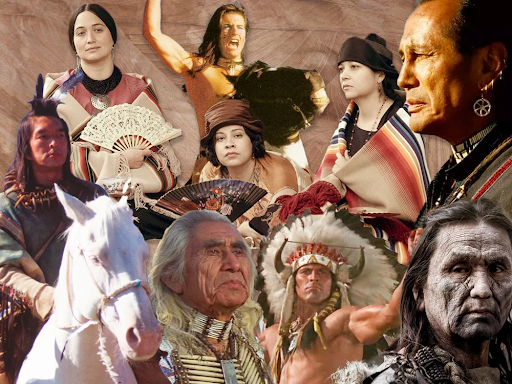Overview
Native Americans in Hollywood

Author:
Lynelle Sigona (Amah Mutsun) Education Specialist
Maggie Peters (Yurok/Karuk) NASMC Learning Specialists Humboldt County Office of Education
Grades: 8, 9-12
Suggested Amount of Time: Four 55 minute Sessions
Curriculum Themes
- History
- Cross Curricular Integration
Learning Goals
Evaluate the portrayal of Native Americans in Hollywood to identify a specific political agenda that justifies the United States treatment of Native Americans.
Analyze how colonial propaganda during the 19th century influenced early Hollywood portrayals of Native Americans, and assess the enduring impact of these portrayals on contemporary media.
Evaluate the role of Native American filmmakers and actors in challenging and reshaping Hollywood narratives, and discuss the significance of authentic representation in media.
Unit Overview
Hollywood’s portrayal of Native Americans has long been intertwined with American politics and government policies, influencing national attitudes toward Indigenous peoples of North America. From the silent film era through the height of Cowboy and Indian Westerns, Hollywood shaped a narrow and damaging image of Native people. These films often depicted Native Americans as ignorant, lazy, violent, alcoholics, or savages, reinforcing harmful stereotypes. Such portrayals helped justify and support racist government policies including land dispossession, forced assimilation, cultural erasure, and even genocide.
This racist foundation in the media was built on earlier political propaganda that framed Native Americans as obstacles to progress and civilization. Hollywood used humor and familiar storytelling to entertain audiences while dehumanizing Indigenous people and upholding white supremacy. The stereotypes created in these early films perpetuated racist propaganda from colonization, solidifying a negative public opinion and masked the harsh realities of U.S. policies against Native nations. Understanding this history is essential for students to recognize how the media can reinforce racism and shape social attitudes over time.
This lesson invites students to critically analyze the power of film as a cultural force and to explore the importance of accurate and respectful representation of Native Americans in the media today. Through examining the origins of racist portrayals and their connections to political propaganda, students will learn to identify the damage caused by such misrepresentations. They will also have the opportunity to research authentic Native stories and consider how these narratives could be shared in ways that promote social justice and cultural respect.
Teacher Background
To effectively address the historical and ongoing misrepresentation of Native Americans in the media, educators must cultivate a classroom atmosphere rooted in empathy, critical thinking, and cultural respect. This begins with self-reflection and awareness– examine personal biases and the potential impact of your teaching materials and methods. Engaging students in open dialogues about race, culture, and media representation encourages them to question stereotypes and develop a deeper understanding of Indigenous perspectives.
Incorporating collaborative learning strategies can enhance a safe communal learning environment. Emphasize shared learning experiences, where students and educators learn from each other in a horizontal, non-hierarchical manner. Promote mutual respect and understanding and allow students to actively participate in their learning journey and recognize the value of diverse cultural narratives.
Empowering students to become agents of change involves providing them with the tools and opportunities to critically analyze media representations and their societal impacts. By guiding students to examine how stereotypes have been perpetuated through historical and contemporary media, educators can inspire them to challenge these narratives and advocate for authentic Indigenous voices. This approach not only combats cultural erasure but also fosters a generation of students committed to promoting social justice and equity in media representation.
Note: You will need to cut and paste search terms to watch movie clips during session two, and possibly three of this lesson to watch movie clips. Review your school’s policy on showing films and get permission slips if needed. Some clips will include violence - nothing is rated R.